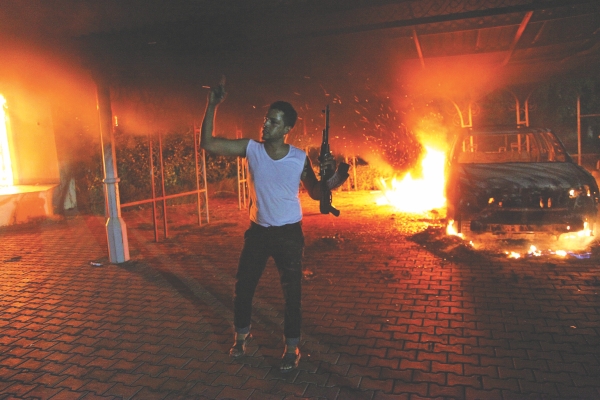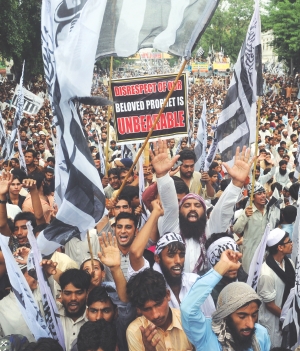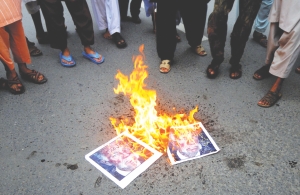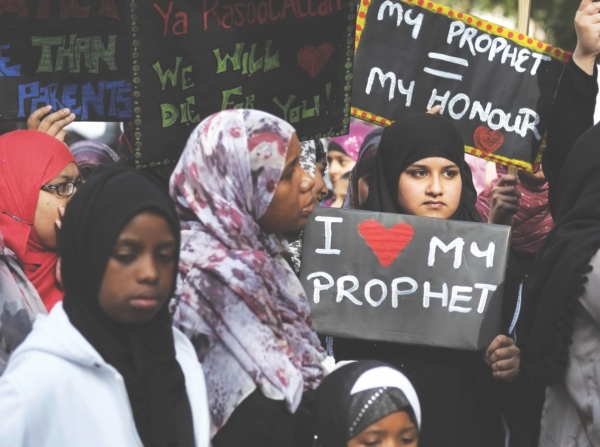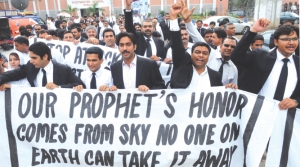| Home - Back Issues - The Team - Contact Us |
 |
| Volume 11 |Issue 37| September 21, 2012 | |
|
|
Perspective
The Clash of Intolerances Sushmita S Preetha The controversial video depicting the Prophet Mohammed in an offensive light, in itself, in another time and place, might have solicited a different response. In fact, it might have solicited no response at all, apart from a few comments registering outrage, disgust or shock. Some moderate ones might even have laughed at the extravagant display of shallowness, intolerance and bigotry, dismissing it as a crude joke that is far from funny.
In today's day and historical juncture, however, can we really expect the video to be taken simply as “an idiotic video”, to be laughed at and forgotten, as so many people all over the world seem to suggest? Consequently, can we dismiss the ensuing violence in the Middle East as an overdramatic and characteristically “Muslim” reaction to a “joke”, given the complex history of US imperialism in the region for over half a century”? The 13-minute trailer portrayed the Prophet Mohammed in the vilest possible manner. It was incredibly poorly made; the directing, acting, editing, set design etc were atrocious, and the content of the film downright offensive, reeking of anti-Muslim sentiments. Written, directed and produced by what is now reported to be Christian extremists, the video was aimed to provoke outrage – although one doubts if even the makers could have hoped for a more striking response. Since the video went viral after it was translated into Arabic and aired in TV channels in different countries across the Middle East, it has given rise to a series of demonstrations and often violent protests in at least 20 countries. The most notable and upsetting result was the death of four American Embassy staff in Libya, including the Ambassador himself. The death and injury tolls continue to rise as people gather outside of embassies, schools and even KFCs, burning tires, containers, American and Israeli flags and effigies of Obama, throwing stones and shouting anti-American chants to portray their outrage at the offensive video. Of course, there is no excuse for the overwhelming extent of violence in response to the video, no matter how offensive and blasphemous the deliberate attack on the Prophet might have been to Muslim sentiments. From what I know of the religion, Islam itself has never advocated for such ruthless acts of violence; the Prophet himself always preached compassion and forgiveness, and the Quran, too, has on many occasions highlighted that it is not up to us, but to Allah, to pass the ultimate judgment.
The latest surge of unrest, with its conflation of one extremist video with America or the West in its entirety, is certainly disturbing, and is tantamount to the conflation of one extremist terrorist with the whole Muslim world. However, before dismissing such acts of violence simply as unnecessary, extreme and bigoted, we should at least ask ourselves: where is all this hatred coming from, and who or what forces are responsible for perpetuating and facilitating this vicious cycle of divisiveness? It is common knowledge now (only in specific circles, of course) that the US's strategic interest and its obsessive intervention in the Middle East is directly responsible for the debilitating condition of much of the Muslim world. People are frustrated with the incalculable damage caused to their families and their nations, in the form of wars, civilian deaths, torture, human rights violations, instability, sectarian divide, extremist fundamentalisms... all meticulously orchestrated by the imperial powers. People are no longer willing to accept the discourse of “upholding freedom, democracy and human rights” posited to exert control over the region's resources and internal politics. No wonder there is a growing anger and resentment towards the West's ostentatious hypocrisy and hegemony. The US has now moved from its earlier strategy of occupation (after all, neo-liberal imperialism is nothing if not adaptable) to aiding strategic rebel groups in the newly-sprung democracies to come to power, as demonstrated in the case of Libya. The air raids and bombings are justified in the name of saving the populations from the possibility of mass violence. Meanwhile, in countries like Bahrain and Yemen, the US supports states to curb popular movements; if that fails, it assists newly emerging groups financially and otherwise to buy their loyalty once in power. What began as an organic revolutionary process in the region has now essentially been co-opted to ensure that the kind of freedom that results is compatible with Western interests. While the West may think that it is pulling wool over their eyes, the citizens of these countries are not blind; even the most naïve of them have learnt to question the integrity and intention of Western powers in the region.
As such, given this complex and volatile situation, the outrage over the film cannot be explained by an oversensitive and melodramatic Muslim temperament. As Myriam Francois-Cerrah writes, in one of the few critical pieces written on the violence: “Though many might have believed the US government could act to restrict the film's diffusion, censorship being altogether common in many of these countries, the focus on American symbols – embassies, American schools – even KFC – suggests the roots of popular anger is not hurt religious pride. These symbols of America were not the unwitting target of frustration over a film – rather the film has provided an unwitting focal point for massive and widespread anger at US foreign policy in the region. If the Arab revolutions let the dictators know exactly how people felt about their repression, these demonstrations should be read as equally indicative of popular anguish with the US's role in the region.” But let us not, in our haste to explain the cause of such anger and resentment, justify extremist acts of hatred and religious intolerance. What is the context of such extremism? On one hand, the growing Islamophobia around the world and the consequent marginalisation of Muslims have driven more and more hitherto liberal or moderate Muslims to embrace religion, even radical interpretations of religion, as a shield. Extremist groups have been able to exploit the anguish, hopelessness and vulnerability felt by Muslims to spread their messages of intolerance. On the other hand, on a broader geo-political level, extremist fundamentalisms (of all kinds) have been funded and facilitated by neo-liberal states; economic fundamentalism and religious fundamentalism, after all, go hand-in-hand, feeding off of each other, strengthening each other. Radical Islamists – and discourses surrounding them – are not only necessary, but essential, to the maintenance of political, economic and military might of the US and its allies regionally and globally. Noam Chomsky, the prominent political critic, writer and activist, argues that it's not radical Islam that worries the US – it's independence: “The general threat has always been independence. The US and its allies have regularly supported radical Islamists, sometimes to prevent the threat of secular nationalism.” The US continues to support Saudi Arabia, the ideological Mecca of radical Islam, responsible for the rapid (and troubling) rate of Islamisation in much of South and South East Asia. The 13-minute video then, in all its crudeness, is a powerful cultural and political artefact, signifying the complex terrain of US-Islam relations. It underlines the intersections and negotiations between US foreign policy in the Middle East, neo-liberal imperialism, upcoming US elections, Islamophobia and extremist Islamisation (to name just a few). It also functions as a reminder of how easy it is to spread and foster hatred and bigotry in this globalised world. |
||||||||||||
Copyright
(R) thedailystar.net 2012 |
